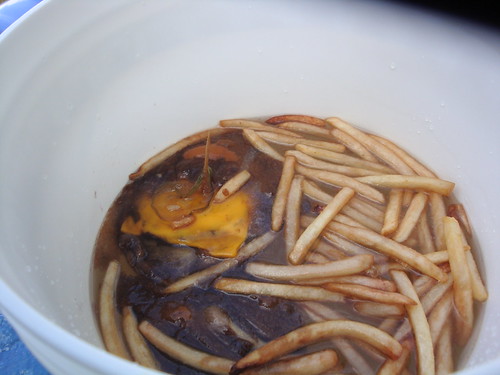
Apparently, it has become the cool thing to collect McDonald's hamburgers, leave them out, and document the progress (or lack thereof) as the burgers [fail to] decompose. The Daily Mail reports a story about artist Sallie Davies and her photo journal of a cheeseburger and fries meal that has lasted six months. And this Youtube video tells the story of a man who began collecting McDonald's burgers in 1989 to watch their lack of change. His story was featured in Morgan Spurlock's Eat This Book, which prompted Len Foley to start his very own "Burger Museum," and to create the Youtube video linked above (which climaxes with a list of trillions [an exaggeration] of chemicals implied to be inside McDonald's meals. . .but in an asterisked comment, Foley says that this is a list of pesticide residues from an FDA report).
It seems that many others are interested in performing similar experiments since Foley gives instructions on how to make your own burger museum and YouTube is flooded with videos of dry, shriveled burgers. But each of these share a similar methodology. Put a value meal on the kitchen counter (Foley warns at-home scientists not to put it in an air tight container because the moisture needs to be allowed to escape, one assumes so that it doesn't mold. Interestingly, for Davies, lack of mold is part of the evidence that something is wrong with these burgers) and wait. The fact that these burgers do not decompose, mold, or change form at all is, it seems, supposed to prove that this food is horribly dangerous. It is so full of chemicals, pesticides, and preservatives that even decomposers won't eat it.
Yet, there is one glaring problem with this evidence. One that is indeed so important that it makes this evidence, well, not evidence at all.
You see, when one eats a hamburger, it does not then sit on a counter top inside your stomach. Instead, you chew it, after which it is squeezed under fairly intense pressure down your esophagus and into a chamber filled with hydrochloric acid, potassium chloride, sodium chloride, and special enzymes. These chemicals work to dissolve the burger as the powerful muscles of the stomach mashs it into chyme, a process that in no way resembles sitting on a counter top.
So, in order to collect more valid results, I have performed an experiment which more closely replicates the conditions actually present in the body. Namely, instead of placing a value meal on the counter top, I placed it into a bucket of muriatic acid, a commercially available hydrochloric acid solution. I didn't design any way to replicate the process of muscular contractions that break down the food in an actual stomach. The little stirring that I did while trying to find pieces of the dissolving burger will have to suffice as a very under-stated simulation for that process.
In addition to achieving more valid result from my experiment, it (I am pleased to report) also took far less effort. Davies has had to take a photograph a day for 170 days, all the while having an aging hamburger stinking up her kitchen. I only took 12 pictures over the course of just over three hours. You can see my results on flikr. In short, the acid made quick work of the meal. . .and so does your body.
Placing a hamburger on a counter top and watching it [fail to] decompose proves exactly nothing, because it's not at all a valid representation of how your body works to dispose of food. The fact that this burger survived on a counter top does not mean that our body will likewise be unable to handle it. In fact, I didn't think about chucking a piece of counter top in there with the burger, but if I had, and if I had left it in there long enough, I bet it would have taken care of that too. Marvelous thing, the human body. We are wonderfully and fearfully made.
I'm not saying that we should all go out and start eating an all McD's diet. After all, Super Size Me alerted us to the dangers of that. Besides, it is fattening, it's high in sodium, and it tastes like what your body turns it into. What I am saying is that we must be more critical when we look at what people use as evidence. The fact that some phenomena is shocking to us does not mean that it proves anything. What we see in these blogs and websites and photo galleries is a fallacious (perhaps even unethical) use of pathos appeal. Because these stories and pictures elicit revulsion, they are used to support arguments that these items really can't support. Perhaps (well, almost undoubtedly) we should change our eating habits. But if we change based on this evidence, we have been duped.